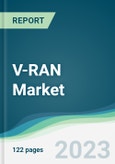The global V-RAN market is projected to grow at a CAGR of 31.86% to reach US$4,337.05 million by 2028 from US$824.949 million in 2022.
Companies in the virtualized RAN (vRAN) market have been inventing solutions that segregate network operations from processing hardware to assist end users save money on network maintenance. Furthermore, this allows several suppliers to operate their RAN network functionalities on a single piece of hardware at the same time. For instance, Samsung has a cloud-native, fully virtualized RAN. It liberates operators from static hardware-bound networks enabling flexible software-centric networks. Its benefits include efficient management, flexible network architecture, and scalable rollouts. Samsung vRAN also ensures powerful performance, high reliability, and time-stringent processing similar to traditional RAN.
Furthermore, according to Samsung, a 13% reduction in total cost ownership can be observed with V-RAN.
GROWTH DRIVERS
Growing benefits of virtualized RAN
As a solution that is future-proof and satisfies evolving network technology needs, vRAN offers a number of advantages. Virtualizing network tasks also reduces the CAPEX and OPEX costs associated with network deployment and operation. These can be influenced by the two following important and operator-attractive benefits of virtualization: (1) operation on the common platform instead of dedicated hardware and (2) implementation with software-based cloud technology.Operation on the common platform instead of dedicated hardware
The end-to-end single uniform platform can provide substantial advantages for operators across the core network, CU, DU, and edge applications such as mobile edge computing (MEC), resulting in increased synergies and an improved return on investment for vRAN. For instance, Samsung's completely virtualized 5G end-to-end solutions, which include virtualized core, vCU, and vDU, can offer operator and industry cloud-based network solutions on a cloud platform.Implementation with software-based cloud technology
The software-based virtualized cloud technology provides the operator the flexibility to add new features and deploy them to a system as needed. This dynamically modifies network resources when required to handle unexpected traffic spikes better. Additionally, any unused resources at a particular site can be used by other sites in a computing cloud, which lowers the cost of baseband processing for each radio site and boosts the effectiveness of the operator's complete infrastructure.Lower operational and maintenance cost
VRAN offers a unified hardware platform across the core network. It aids in the simplification of overall network management while also lowering operating and maintenance costs.Companies in the virtualized RAN (vRAN) market have been inventing solutions that segregate network operations from processing hardware to assist end users save money on network maintenance. Furthermore, this allows several suppliers to operate their RAN network functionalities on a single piece of hardware at the same time. For instance, Samsung has a cloud-native, fully virtualized RAN. It liberates operators from static hardware-bound networks enabling flexible software-centric networks. Its benefits include efficient management, flexible network architecture, and scalable rollouts. Samsung vRAN also ensures powerful performance, high reliability, and time-stringent processing similar to traditional RAN.
Furthermore, according to Samsung, a 13% reduction in total cost ownership can be observed with V-RAN.
EMERGING OPPORTUNITIES IN THE GLOBAL V-RAN MARKET
DU
By architecture, V-RAN is divided into CU, DU, and RU. DU will hold a major proportion in volume terms during the projected period, owing to its important positioning in baseband deployment. To achieve the lowest latency, the industry has concluded that the lower-level interface connecting RU and DU (fronthaul) should be eCPRI. The fronthaul latency is limited to 100 microseconds. A single DU may serve RUs located several kilometers away.GEOGRAPHICAL PRESENCE
The global V-RAN market includes some major countries such as the USA, Japan, South Korea, China, and Germany. Various developments can be witnessed by some of the major players, with a couple of them listed below:- In January 2021, Samsung and KDDI formed an alliance to launch 5G vRAN in Japan. Samsung deployed its cloud-native fully virtualized Radio Access Network (vRAN) solutions for the mid-band spectrum in KDDI’s 5G network. The alliance also collaborated on advanced research on vRAN to drive 5G innovation for KDDI’s network.
- In December 2022, Samsung deployed 10,000 vRAN cell sites across the US along with Verizon. The step has been initiated toward achieving Verizon’s goal of deploying 20,000 vRAN sites by 2025. Samsung’s 5G vRAN solutions provided Verizon with a network that scales easily, allows for rapid upgrades, and can be flexibly managed with centralized resources.
MAJOR PLAYERS IN THE MARKET
Some of the leading players in the market include Ericsson, Verizon, and Samsung. These firms have undertaken various business strategies such as product launches, investments, and partnerships to expand their product offerings. For instance,- In August 2021, Samsung announced its next-generation Virtualized RAN with enhanced capabilities. Its capacity will be increased by using hardware accelerators.
- In June 2022, Ericsson announced the commercialization of its next-generation 5G AirScale Cloud RAN solution based on vRAN2.0. It has a virtualized Central Unit (vCU). The product allows the operators to meet IoT requirements, to generate revenue from new 5G services while gaining the overall benefits of cloud computing to Radio Access Networks (RAN).
- In September 2022, Verizon deployed more than 8000 vRAN cell sites. It has the goal of deploying over 20,000 by the end of 2025.
MARKET SEGMENTATION
The global V-RAN market has been analyzed through the following segments:By Spectrum Band
- Sub-6 GHz
- mmWave
By Architecture
- CU
- DU
- RU
- Others
By Geography
- Americas
- United States
- Others
- Europe, the Middle East, and Africa
- Germany
- UK
- Others
- Asia Pacific
- China
- Japan
- South Korea
- Others
Table of Contents
1. INTRODUCTION
2. RESEARCH METHODOLOGY
3. EXECUTIVE SUMMARY
4. MARKET DYNAMICS
6. V-RAN MARKET, BY SPECTRUM BAND
7. V-RAN MARKET, BY ARCHITECTURE
8. V-RAN MARKET, BY GEOGRAPHY
10. COMPETITIVE ENVIRONMENT AND ANALYSIS
11. COMPANY PROFILES
Companies Mentioned
- Fujitsu
- Samsung
- Qualcomm Technologies
- Nokia
- Mavenir
- Cisco
- NEC
- Airspan
Methodology

LOADING...








